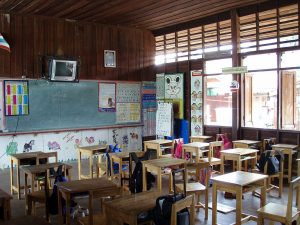Tipping Point – ChatGPT and Assessment
Like many tools before it, the introduction of publicly available Generative Artificial Intelligence models incited panic, outrage, and reflection in the world of education. It forced many educators to revaluate their assessment methods to account for a tool that can fluently provide an answer to any question, generate written material on any subject, and do so with such convincing quality that it is indiscernible from human output.
Behaviourism
Every other word uttered by students is a swear and they are incredibly disrespectful toward themselves, each other, the teacher, and the physical environment. One student is so keen on being in the room that they won’t let the teacher talk without interrupting with questions. Three other students keep talking to their neighbours and distracting them regardless of how many times the teacher waits for silence (which ends up about 25 minutes the first time on the first day).
Social and Emotional Learning
When the Truth and Reconciliation Calls to Action came out, Ms. Miller’s school was required to teach all students, of all ages, about the truths of Indian Residential Schools (IRS). Orange Shirt Day was coming up fast and Ms. Miller and her colleagues (mainly white teachers) struggled with what and how to teach in this area, having limited experience and knowledge about IRS.
Diversity, Equity and Inclusion
I am a motivated teacher candidate in the Middle Years cohort, ready to support inclusion and diversity! Yet, I don’t feel completely confident engaging with decolonizing and anti-racist possibilities. I have been assigned to teach a grade 7 class and am thinking about how I can use inclusive and diverse teaching resources. I asked for advice from my School Advisor (SA).
Bullying Prevention
Mina is a teacher candidate in the first semester of her program. She visits her practicum classroom once a week on Thursday in a school where 56 languages are spoken by children and their families. She did not grow up in this community, but is excited to learn. She recently moved to British Columbia and most of her education in K-12 was in a private school where students and families shared many religious and cultural values, language, and mores. Her parents are both professionals and encouraged her desire to become a teacher. Her practicum school is a middle school (grades 6-8) and she will be teaching core subjects in a grade 7/8 multiage classroom.
Teacher Blogger
Sarah has recently begun her first contract as a certified teacher at a high school in Vancouver. The position allows her to teach Physical Education and coach one of the school’s basketball teams, which is exciting for her, as she is able to bring together her love of working with students and her passion for fitness. She is not sure, however, that she will teach for her entire career. In fact, she thinks that in the future she might want to work as a personal trainer or run her own personal training company. She has thought about doing this since she began working part time as a fitness coach a few years ago to help her pay her tuition at UBC, something she is continuing to do as a new teacher to help pay her student loan debt.
Snapchat Mishap
After being encouraged to take advantage of communication apps as a teaching tool with her high school Social Studies classes at the beginning of her practicum, Jessica decided to make teaching accounts on a few different apps and websites in order to engage her students. Having looked her up online prior to the start of her practicum, Jessica’s school advisor suggested that, if she wanted to use social media, she should probably make her current accounts private and consider creating new accounts to use with her classes. After discussing the idea and getting permission to create school-related social media accounts on Facebook, Twitter, and Snapchat with the school administrator, Jessica made the accounts under her name Ms. Yu.
Rate My Teacher Candidate
After hearing stories about teachers being disciplined or criticized for online posts, Mateo decided not to use social media during his practicum. He was not a regular user of social media anyway, having only a Facebook account that he posted on occasionally. Between using the highest available privacy settings and continuing to post very little from the account, Mateo felt confident that he was unlikely to run into any problems related to social media while teaching. While completing his practicum, he knew other teacher candidates who had multiple social media accounts and were more active online. They would sometimes express concern over the potential for certain posts or pictures to have a negative effect on their reputations as teachers and Mateo was grateful not to have the same worries.
Questionable Comments
Before beginning their practicums, a group of teacher candidates who were placed in the same school to teach created a private Facebook group and a group chat through text so that they could share resources, discuss their experiences, and plan times to get together outside of school. Because they were all trying to monitor their use of social media in order to avoid breaching any policies, they decided to communicate through these private groups, as opposed to posting on any public profiles. Recognizing that they could help one another succeed by monitoring their social media interactions, all of the teacher candidates agreed not to post comments about each other or share any photos from their parties without asking for permission, especially if they were drinking alcohol or wearing revealing clothing that they would not wear while teaching.
Pop-Up Problem
Shira is always looking for creative ways to engage the grade 3 students she is teaching in her practicum. While searching online for fun ideas to incorporate into one of her upcoming art classes, she comes across a lesson plan that involves painting using toy squirt guns, which she thinks her students would enjoy. While her students are working on their math problems, Shira decides to search for inexpensive squirt guns she can purchase to use with the lesson. She uses a personal laptop that she brought to school because her school advisor is using the classroom computer for her own work.









